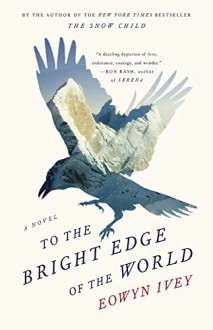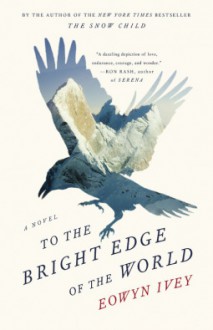
Wow. I don't have much to say except that I really enjoyed this book from beginning to end. I have never read a book by Eowyn Ivey before and will definitely seek out more works. This book really made me want to crawl out into the woods under a starry sky in the middle of winter and just take a deep breath and let it just roll over me. I thought the character development of Jack and Mabel really worked. Also loved how Ivey dealt with the character of Faina as well. We also get another point of view eventually with a boy that Jack and Mabel watch grow up and start to see as a son. I thought the setting really worked and the ending was definitely bittersweet.
"The Snow Child" centers around a middle-aged couple named Jack and Mable. Ten years earlier they lost a baby and almost lost each other. They eventually moved from Pennsylvania to Alaska. The story takes place in the 1920s and you have Ivey showcasing an Alaska that is wild and also harsh. After making a snow child in the woods one night outside their cabin, Jack and then Mable see a young girl in the woods. And Mabel wonders if they made this child that seems to thrive in snow and cold. The book shows Mabel and Jack both dealing with loving and worrying over this young girl who they eventually find out is named Faina. And we follow them through the years as she grows up and they grow up along with their neighbors who they start to see as family as well.
Mabel and Jack have your hearts right away. You wonder what could have a couple this old out in the Alaskan wilderness, but you find out. They are on the verge of losing each other until Jack meets the Benson family who end up bringing a spark back to them and their marriage. When they eventually come across Faina you have them both thinking of the child they have lost and getting another one in a strange way. Ivey leads you to find out the beginnings of Faina, but you are constantly wondering if she is a child/young woman or something else.
I thought that Ivey played very nicely with the magical realism aspects of this book. Things are subtle here and there and sometimes more overt. I liked it and thought that it fit the mood of the book very well. The flow of the book worked and we end up getting three parts to this book with Jack and Mabel first meeting Faina then 6 years passing, and then eventually years after that as well.
The setting of Alaska during the winter months made me long for hot chocolate and fire. However, you get to see the beauty in the snow and the air and everything that comes alive during the winter. Same when the story moves to spring and summer.
The epilogue was great and you are left with a great sense of family and belonging in the end.


 Log in with Facebook
Log in with Facebook 








